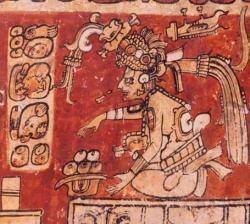Itzamná
Da Ufopedia.
(Differenze fra le revisioni)
(→Galleria immagini) |
(→Galleria immagini) |
||
| Riga 12: | Riga 12: | ||
Immagine:Itzamna1.jpg | Immagine:Itzamna1.jpg | ||
Immagine:Itzamna-arriving.jpg | Immagine:Itzamna-arriving.jpg | ||
| - | Immagine: | + | Immagine:Itzamnabis.jpg |
Immagine:Ixchel.jpg | Immagine:Ixchel.jpg | ||
Immagine:Ixchelgfd.jpg | Immagine:Ixchelgfd.jpg | ||
Versione delle 11:46, 9 ott 2013
Nella mitologia maya, Itzamnà, figlio di Hunab Ku, è governatore degli dèi, dio del sole, del mais, della scrittura e delle arti.
È rappresentato come un sereno vegliardo dal prominente naso. Itzamnà era il più antico della prima generazione degli dèi del pantheon maya, e fu la principale delle divinità maya fino all' 800 d.C., quando, dopo l'invasione degli Aztechi, fu soppiantato dal dio Tezcatlipoca. Non è chiara l'etimologia del suo nome, forse riferibile ad una grossa lucertola o caimano (itzam) oppure alla rugiada (itz).
Galleria immagini
Bibliografia
- Thompson, J.Eric S.(1970). Maya History and Religion, Civilization of the American Indian Series, No. 99. Norman: University of Oklahoma Press. ISBN 0-8061-0884-3. OCLC 177832
- The Columbia Encyclopedia, Sixth Edition 2007
- Ferdinand Anders, Das Pantheon der Maya.
- Nicholas Hellmuth, Monsters and Men in Maya Art.
- Houston, Stuart, Taube, The Memory of Bones.
- Simon Martin and Nikolai Grube, Chronicle of the Maya Kings and Queens.
- David Stuart, The Inscriptions from Temple XIX at Palenque.
- Karl Taube, The Major Gods of Ancient Yucatan.
- Karl Taube, A Representation of the Principal Bird Deity in the Paris Codex.
- Eric Thompson, Maya History and Religion.
- Alfred Tozzer, Landa's Relacion de las Cosas de Yucatan.













